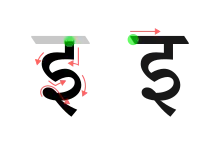इ
 | ||||||||
| ||||||||
Translingual

Stroke order
Pronunciation
- IPA(key): /i/, /ɪ/ (may vary by language)
Letter
इ (i)
- A vowel of the Devanagari script. Its matra, used to modify the inherent vowel in a consonant is written ि. For example the first consonant क with the matra looks like: कि. The matra should appear before the consonant it modifies, though it is pronounced after.
Derived terms
Dhivehi
Pronunciation
- IPA(key): [i]
Hindi
Pronunciation
- IPA(key): /ɪ/, /i/ (at the end of words)
Audio (file)
See also
- (matra): ि (i)
- (Devanagari script letters) अ, आ, इ, ई, उ, ऊ, ऋ, ए, ऐ, ओ, औ, अं, अः, अँ, क, ख, ग, घ, ङ, च, छ, ज, झ, ञ, ट, ठ, ड, ढ, ण, त, थ, द, ध, न, प, फ, ब, भ, म, य, र, ल, व, श, ष, स, ह, त्र, ज्ञ, क्ष, क़, ख़, ग़, ज़, झ़, ड़, ढ़, फ़ (Category: Hindi letters) [edit]
Sanskrit
| Sanskrit verb forms | |
|---|---|
| Present | एति (eti) अयति (ayati) |
| Causative | आययति (āyayati) |
| Desiderative | ईषिषति (īṣiṣati) |
| Intensive | ईयते (īyate) |
Alternative scripts
Alternative scripts
- ই (Assamese script)
- ᬇ (Balinese script)
- ই (Bengali script)
- 𑰂 (Bhaiksuki script)
- 𑀇 (Brahmi script)
- ဣ (Burmese script)
- ઇ (Gujarati script)
- ਇ (Gurmukhi script)
- 𑌇 (Grantha script)
- ꦆ (Javanese script)
- 𑂅 (Kaithi script)
- ಇ (Kannada script)
- ឥ (Khmer script)
- ອິ (Lao script)
- ഇ (Malayalam script)
- ᡳ (Manchu script)
- 𑘂 (Modi script)
- ᠢ (Mongolian script)
- 𑦢 (Nandinagari script)
- 𑐂 (Newa script)
- ଇ (Odia script)
- ꢄ (Saurashtra script)
- 𑆅 (Sharada script)
- 𑖂 (Siddham script)
- ඉ (Sinhalese script)
- 𑩐𑩑 (Soyombo script)
- 𑚂 (Takri script)
- இ (Tamil script)
- ఇ (Telugu script)
- อิ (Thai script)
- ཨི (Tibetan script)
- 𑒃 (Tirhuta script)
- 𑨀𑨁 (Zanabazar Square script)
Etymology 1
From Proto-Indo-Aryan *Hay-, from Proto-Indo-Iranian *Hay-, from Proto-Indo-European *h₁ey-. Cognate with Ancient Greek εἶμι (eîmi, “I go”), Mycenaean Greek 𐀂𐀍𐀳 (i-jo-te), Old Persian 𐎠𐎡𐎫𐎡𐎹 (aitiy, “goes”), Luwian 𒄿𒋾 (i-ti /iti, idi/, “goes”), Hittite 𒄿𒄿𒀀𒀜𒋫 (i-ya-at-ta /iyatta/, “goes”), Old Church Slavonic ити (iti), Lithuanian eiti, and Latin eo, iter whence English itinerary.
Derived terms
- अधी (adhī́, “to turn the mind towards, to mind, know by heart, go over”)
- अय (áya, “going”)
- अयन (áyana, “road, path”)
- अर्थेत् (arthét, “active, hasty”)
- आय (āyá, “arrival, approach”)
- आयन (ā́yana, “coming, approaching”)
- आयिन् (āyín, “coming or hastening near”)
- आयु (āyú, “living, movable”)
- इत (itá, “gone”)
- इत्य (itya, “to be gone to”)
- इत्या (ityā́, “going, stepping”)
- इत्वन् (itvan, “going”)
- इत्वर (itvara, “going, walking”)
- ए (√e, “come near, approach; reach, attain; submit”)
- एत (éta, “come near, approached”)
- एत (éta, “rushing, darting”)
- एतवे (étave, “to go”)
- एति (éti, “arrival, approach”)
- एति (éti, “he goes”)
- एतृ (etṛ́, “goer, approacher”)
- एतोस् (étos, “to go”)
- एत्य (étya, “having come near”)
- एनी (enī́, “rushing, darting”)
- एम (éma, “course, way”)
- एमन् (éman, “course, way”)
- एव (éva, “going, moving, speedy, quick”)
- प्रे (√pre, “come forth, appear; begin; proceed, advance; go forwards; go out”)
Etymology 2
From Proto-Indo-European *éy. See also अयम् (ayam).
Alternative forms
- अय् (ay)
Particle
इ • (i)
- base of the nominative and accusative singular dual and plural of the demonstrative pronoun इदम् (idam), ‘this’ or ‘that’
References
- Monier Williams (1899) “इ”, in A Sanskrit–English Dictionary, […], new edition, Oxford: At the Clarendon Press, →OCLC, pages 163/2-3.
- William Dwight Whitney, 1885, The Roots, Verb-forms, and Primary Derivatives of the Sanskrit Language, Leipzig: Breitkopf and Härtel, page 7
- Mayrhofer, Manfred (1992) Etymologisches Wörterbuch des Altindoarischen [Etymological Dictionary of Old Indo-Aryan] (in German), volume 1, Heidelberg: Carl Winter Universitätsverlag, pages 102-3; 185
This article is issued from Wiktionary. The text is licensed under Creative Commons - Attribution - Sharealike. Additional terms may apply for the media files.